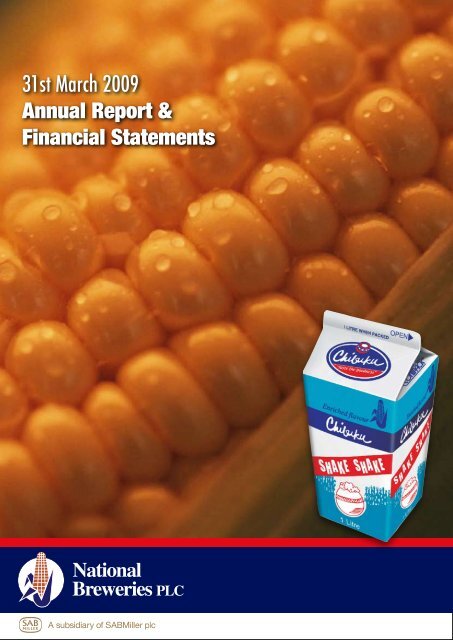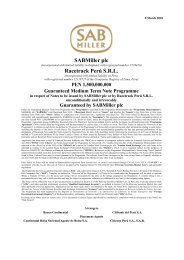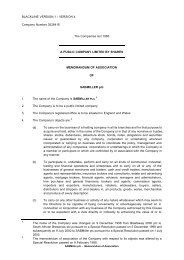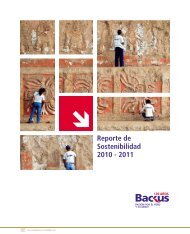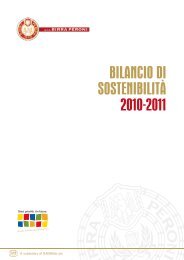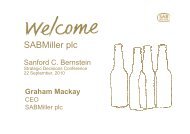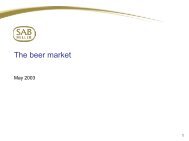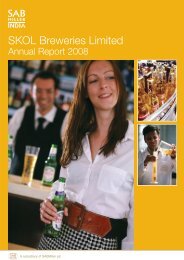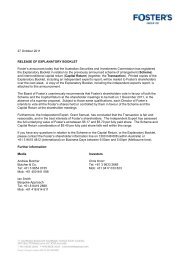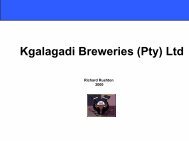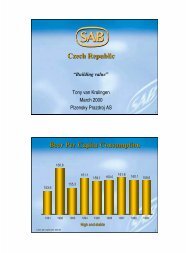Download the National Breweries Zambia 2009 Annual ... - SABMiller
Download the National Breweries Zambia 2009 Annual ... - SABMiller
Download the National Breweries Zambia 2009 Annual ... - SABMiller
Create successful ePaper yourself
Turn your PDF publications into a flip-book with our unique Google optimized e-Paper software.
31st March <strong>2009</strong><br />
<strong>Annual</strong> Report &<br />
Financial Statements
Contents<br />
Table of Contents<br />
Vision, Mission and Values 4 Company Financial Review 6 Chairman’s Statement 7<br />
Managing Director’s Report 9 Sustainable Development Report 11 Report of <strong>the</strong> Directors 12<br />
Directors’ Responsibilities and Statement 15 Report of <strong>the</strong> Auditors 16<br />
Financial Statements:<br />
Profit and Loss Account 18 Balance Sheet 19 Statement of Changes in Equity 20<br />
Cash Flow Statement 21 Notes to <strong>the</strong> Financial Statementss 22<br />
Principal Shareholders and Share Distribution 40 Directorate and Corporate Information 42<br />
Notice of <strong>the</strong> <strong>Annual</strong> General Meeting 44<br />
p03
Mission Statement and Values
Management Team<br />
James Webb<br />
Finance Director<br />
David Cason<br />
General Manager<br />
Ronny Palale<br />
Operations Director<br />
Yuyo Nachali-Kambikambi<br />
Corporate Affairs Manager<br />
Anthony Malenga<br />
Finance Manager<br />
Guntila Muleya<br />
<strong>National</strong> Sales Manager<br />
Fanie Olivier<br />
Technical Manager<br />
Johannes Scriven<br />
<strong>National</strong> Sales &<br />
Distribution Manager<br />
Probby Mwela<br />
Information Technology<br />
Manager<br />
Joshua Mukwaila<br />
Internal Audit Manager<br />
Mwape Chisanga<br />
Human Resource Manager<br />
p05
Company Financial Review<br />
for <strong>the</strong> year ended 31st March <strong>2009</strong><br />
Year<br />
ended<br />
31 March<br />
<strong>2009</strong><br />
Year<br />
ended<br />
31 March<br />
2008<br />
Year<br />
ended<br />
31 March<br />
2007<br />
Year<br />
ended<br />
31 March<br />
2006<br />
Year<br />
ended<br />
31 March<br />
2005<br />
Year<br />
ended<br />
31 March<br />
2004<br />
K Million<br />
Gross turnover 264 983 177 416 168 908 154 414 116 016 65 116<br />
Product taxes/excise duty (76 331) (54 059) (51 523) (46 902) (37 798) (19 459)<br />
Net turnover 188 652 123 357 117 385 107,512 78 218 45 657<br />
Profit before taxation 37 514 35 323 41 025 36 879 25 224 15 464<br />
Profit after taxation 23 814 22 377 26 401 23 192 16 277 10 340<br />
Non current assets 31 264 21 012 16 722 11 864 8 517 5 429<br />
Net current<br />
(liabilities)/assets<br />
(7 187) 3 179 9 017 12 133 19 174 16 040<br />
Deferred income tax (4 473) (2 886) (2 382) (1 881) (1 101) (532)<br />
Shareholders interest (19 604) (21 305) (23 196) (21 616) (25 986) (20 500)<br />
Kwacha<br />
Earnings per share 377.99 355.18 419.06 368.12 258.38 164.13<br />
Dividends per share 377.99 355.18 419.06 368.12 258.38 164.13<br />
p06
Financial Performance<br />
Chairman’s Statement<br />
for <strong>the</strong> year ended 31st March <strong>2009</strong><br />
I am pleased to report to our shareholders that <strong>the</strong> Company posted good results for <strong>the</strong> year improving on<br />
previous year’s performance. The Company regained its lost share of <strong>the</strong> market and record volumes were<br />
reported in this financial year. Our strategy to price aggressively coupled with a well managed distribution<br />
network, yielded positive results. Investment in technical areas ensured that our product quality was consistent<br />
in line with our mission. The Company did face challenges, however, in <strong>the</strong> form of high commodity<br />
prices in particular crude oil. This resulted in high fuel prices adversely affecting our distribution costs. The<br />
weakening of <strong>the</strong> kwacha in <strong>the</strong> second quarter put pressure on certain input costs fur<strong>the</strong>r eroding our trading<br />
margin. Despite all this, <strong>the</strong> Company came out with a reasonable performance adding more value to<br />
shareholder investment.<br />
The opaque beer industry will continue to be highly competitive. The Company captured lost share in 2008<br />
to end <strong>the</strong> year in a reasonable position. The Company’s objective will be to maintain its position and add to<br />
<strong>the</strong> current growth while meeting customer expectations with a quality product and service delivery of <strong>the</strong><br />
highest calibre.<br />
Key Results<br />
➢ • Pre-tax profit of K 37,514 million for <strong>the</strong> year (2008: K 35,323 million) up 6.2%<br />
➢ • Gross turnover increase of 49.4% compared to previous year<br />
➢ • Earnings per share of K377.99 (2008: K355.18)<br />
➢ • The Company continues to be debt free<br />
➢ • An interim dividend of K220.93 (2008: K171.11) was paid in February <strong>2009</strong><br />
➢ • A proposed final dividend of K157.06 bringing total dividends for <strong>the</strong> year to K377.99 (2008:<br />
K355.18)<br />
Dividends<br />
An interim dividend of K220.93 per share was paid during <strong>the</strong> year. A final dividend of K157.06 per share<br />
is recommended for approval at <strong>the</strong> annual general meeting which will be paid by 31 August <strong>2009</strong>. This will<br />
be paid to ordinary shareholders registered at close of business on 30 June <strong>2009</strong>. This represents 100%<br />
distribution of profits.<br />
Corporate Governance<br />
The existence of good corporate governance principles is important in running an organisation. The Company’s<br />
Board of Directors and Audit Committee continue to set high standards of Corporate Governance. The<br />
Company continues to adhere to <strong>the</strong> Listing Rules and Securities Rules as enforced by <strong>the</strong> Lusaka Stock<br />
Exchange and Security and Exchange Commission respectively. The Company has also continued to comply<br />
with principles on corporate governance and internal control as set out in <strong>the</strong> Combined Code and Turnbull<br />
Report. The Company is part of a large multinational group that provides considerable support in ensuring<br />
that high standards of corporate governance are maintained.<br />
The Company has made tremendous strides in instilling a change of work ethic throughout <strong>the</strong> business.<br />
Employees are always encouraged to execute <strong>the</strong>ir duties with due diligence, honesty and integrity. Through<br />
<strong>the</strong> Integrity Club formed in 2006, <strong>the</strong> Company has received positive response from employees in <strong>the</strong> fight<br />
against fraud.<br />
p07
Chairman’s Statement<br />
for <strong>the</strong> year ended 31st March <strong>2009</strong> cont.<br />
Human Resource<br />
The Company made key recruitments during <strong>the</strong> year in line with our strategy of Strategic People Resourcing (SPR).<br />
As per our mission statement, people are our enduring advantage and we strive to improve staff welfare all <strong>the</strong> time.<br />
This is in line with our objectives and goals. Training continues to be a key part our strategy; equipping staff with latest<br />
technologies ensuring that we are always ahead of our competitors.<br />
We continue to train more peer educators within <strong>the</strong> business and maintain zero tolerance towards stigmatisation. The<br />
Company remains one of <strong>the</strong> few that procure anti-retroviral drugs for affected employees. We encourage employees<br />
to undergo voluntary testing and counselling and a centre is available within <strong>the</strong> Company premises.<br />
A challenging year lies ahead for every business in <strong>the</strong> wake of <strong>the</strong> current economic conditions and depressed commodity<br />
prices, in particular copper. I have all <strong>the</strong> confidence that, with <strong>the</strong> team available, <strong>the</strong> Company will be guided<br />
professionally and wisely.<br />
In conclusion, I thank <strong>the</strong> Managing Director, Management, staff and <strong>the</strong> Board of Directors for <strong>the</strong>ir support and efforts<br />
during this challenging year and I look forward to more success in <strong>the</strong> 2010 financial year.<br />
V Chitalu<br />
Chairman<br />
8th June <strong>2009</strong><br />
p08
Managing Director’s report<br />
for <strong>the</strong> year ended 31st March <strong>2009</strong><br />
Operating and Economic Environment<br />
The <strong>Zambia</strong>n economy continued to show growth during <strong>the</strong> first quarter of <strong>the</strong> financial year with copper<br />
prices at <strong>the</strong>ir peak. This had an impact on all sectors of <strong>the</strong> economy as production volumes in <strong>the</strong> mining<br />
industry resulted in excess liquidity and a stronger Kwacha. The Country’s economy experienced uncertainties<br />
at <strong>the</strong> beginning of <strong>the</strong> second quarter following <strong>the</strong> President’s illness and eventual death. This caused panic<br />
in <strong>the</strong> financial markets as foreign investors rushed to change <strong>the</strong>ir portfolio mix and notably <strong>the</strong> Kwacha<br />
started to depreciate rapidly. The world economy collapsed with most nations admitting that a recession was<br />
imminent. This did not help <strong>the</strong> cause locally and commodity prices tumbled as global demand stalled. This<br />
impacted <strong>the</strong> mining industry adversely resulting in massive job cuts and closure of some mines. The stock<br />
market suffered a similar fate and share prices fail reversing gains achieved earlier in <strong>the</strong> year. Surprisingly,<br />
<strong>the</strong> property market continued to hold with reasonable gains being posted.<br />
Crude oil prices had mixed results after reaching <strong>the</strong> US$ 140 per barrel mark putting more pressure on<br />
world economies as <strong>the</strong> cost of production and distribution increased substantially. The <strong>Zambia</strong>n economy<br />
was not spared with fuel prices hitting <strong>the</strong> US$3 dollar per litre mark in mid September 2008.<br />
In <strong>the</strong> agriculture sector, <strong>the</strong> flooding experienced in late 2007 and early 2008 resulted in a shortage of <strong>the</strong><br />
maize crop. This sent prices rocketing, doubling on previous year’s levels. The annual inflation rate increased<br />
from 9.8% in March 2008 to 13.1% in March <strong>2009</strong>, comprising 6.8% food inflation and 6.3% non-food<br />
inflation. The annual food inflation increased to 13.9% from 9.1% in March 2008. <strong>Annual</strong> non-food inflation<br />
followed a similar trend rising from 10.4% in March 2008 to 12.3% in March <strong>2009</strong>.<br />
The <strong>Zambia</strong>n Kwacha has depreciated following <strong>the</strong> collapse of <strong>the</strong> copper price on <strong>the</strong> world market. The<br />
local currency reached peak levels of K3,200 in June 2008 to close at K5,620 in March <strong>2009</strong>.<br />
Performance<br />
The Company has posted good results on <strong>the</strong> back of economic challenges highlighted above. The<br />
weakening Kwacha resulted in rise in input costs in particular packaging and energy costs. Soaring maize<br />
prices increased production costs and <strong>the</strong> effect of high fuel prices cannot go without mention. The Company<br />
met <strong>the</strong>se challenges with well planned distribution strategies and competitive pricing not undermining<br />
consistent quality in <strong>the</strong> production process. The Company posted record volumes establishing itself in <strong>the</strong><br />
market and regaining lost share to end <strong>the</strong> year strongly. Whilst we recorded a double digit growth in gross<br />
turnover, operating profit did not follow suit due to increased costs as explained above.<br />
Our strategy to grow packed beer volume continued with a strong performance out of <strong>the</strong> total portfolio.<br />
Despite <strong>the</strong> uncertainty and speculation surrounding <strong>the</strong> mining industry, <strong>the</strong> Copperbelt recorded good<br />
volume.<br />
In ensuring that we produce a consistent quality product, <strong>the</strong> Company continues to maintain its equipment<br />
to <strong>the</strong> highest levels through planned and preventative refurbishment. Our electronic process monitoring<br />
continues at all our production plants and this is yielding positive results. We aim to benchmark ourselves<br />
with our regional partners to ensure that high standards are maintained. The Company invested K10 billion<br />
in distribution resources increasing and replacing vehicles in <strong>the</strong> delivery fleet. This has paid off with our<br />
network growing substantially. Vehicle monitoring equipment is installed on all <strong>the</strong> delivery fleet. This has<br />
resulted in improved service delivery and cost saving in fuel usage and vehicle maintenance costs.<br />
p09
Managing Director’s report<br />
for <strong>the</strong> year ended 31st March <strong>2009</strong> (cont.)<br />
We have achieved pre-tax profits of K37,514 million (2008: K35,323 million).<br />
The Company’s contribution to <strong>the</strong> State, in <strong>the</strong> form of VAT, Excise Duty and Corporate tax during <strong>the</strong> year was K90<br />
billion (2008: K67 billion) a 34% increase.<br />
As mentioned in <strong>the</strong> Chairman’s report, <strong>the</strong> Company paid an interim dividend during <strong>the</strong> year of K220.93 per share.<br />
A final dividend of K157.06 per share will be paid bringing <strong>the</strong> total dividend for <strong>the</strong> year to K377.99 per share. This<br />
represents an increase of 6.4% against 2008.<br />
Current and future prospects<br />
Our main objective will be to maintain volume and post more growth to add more value to our shareholders’ investment.<br />
The outlook for <strong>the</strong> economy is positive as commodity prices start to pick up. Copper prices have touched US$ 4,800<br />
per ton levels last seen in November 2008. This is good news for <strong>the</strong> Copperbelt as fur<strong>the</strong>r job losses will be curtailed<br />
and economic activity restored.<br />
The maize crop is expected to be in abundance with a good harvest season predicted. This will be welcome in as far as<br />
<strong>the</strong> Company’s input costs are concerned. The outlook for <strong>the</strong> Kwacha remains gloomy with financial market experts<br />
supporting a recovery. This has a direct impact on certain inputs.<br />
More will depend on <strong>the</strong> recovery of <strong>the</strong> global economy. This will lead to more Foreign Direct Investment (FDI) trickling<br />
into <strong>the</strong> economy to revamp <strong>the</strong> manufacturing industries. Expansion for most business entities will be dependent on<br />
availability of credit at <strong>the</strong> right price as current borrowing costs are relatively high.<br />
The Company has a strong management team in place and is well positioned to meet <strong>the</strong> challenges that lie ahead in<br />
<strong>the</strong> new financial year. Key focus areas for management will incorporate <strong>the</strong> following:<br />
• to maintain volumes and explore growth opportunities<br />
• to continue with our high service delivery and customer satisfaction with a consistent and quality product<br />
• continue with training initiatives for our employees<br />
• planned preventative maintenance to maintain production equipment to high standards<br />
• more community support in <strong>the</strong> markets we operate in<br />
• maintain group standards in IT infrastructure and explore opportunities to improve MIS<br />
W J Tiedt<br />
Managing Director<br />
8th June <strong>2009</strong><br />
p10
Sustainable Development report<br />
for <strong>the</strong> year ended 31st March <strong>2009</strong><br />
Sustainable Development<br />
Because Sustainable Development is ‘a pattern of resource use that aims to meet human needs while preserving<br />
<strong>the</strong> environment so that <strong>the</strong>se needs can be met not only in <strong>the</strong> present, but also in <strong>the</strong> future generations to come,’<br />
<strong>National</strong> <strong>Breweries</strong> believes it can make a difference in many spheres through various sustainable development<br />
activities in line with <strong>SABMiller</strong>’s most valued 10 priorities.<br />
Activities and Projects<br />
Alcohol Policy:<br />
Bearing in mind that we work for a beer company it is imperative for all our members of staff especially to know <strong>the</strong><br />
effects of alcohol abuse, <strong>the</strong> dangers of drink & driving and also dangers of under age drinking. Therefore <strong>National</strong><br />
<strong>Breweries</strong> Plc embarked on a roll out of <strong>the</strong> Alcohol Behaviour Communication (ABC), which will this year be rolled<br />
out to every member of staff including some key stakeholders and partners so that we are in <strong>the</strong> long run able to<br />
communicate meaningful messages to <strong>the</strong> wider public with us being in <strong>the</strong> lead to discourage <strong>the</strong> above vices.<br />
HIV/AIDS:<br />
Understanding that HIV/AIDS is <strong>the</strong> biggest killer of <strong>Zambia</strong>’s workforce, <strong>National</strong> <strong>Breweries</strong> Plc embarked on a<br />
sensitisation program which included <strong>the</strong> training of several Peer Educators from all area offices.<br />
Corporate Social Investment (CSI):<br />
The company invested in several projects and gave monies to orphanages like Cheshire Homes, <strong>the</strong> <strong>Zambia</strong> Federation<br />
for <strong>the</strong> Blind, and also managed to assist in giving cartons of Maheu to <strong>the</strong> flood victims in Kazungula district.<br />
Enterprise Development:<br />
In a bid to support enterprise development, <strong>National</strong> <strong>Breweries</strong> Plc supported over 3,000 small scale farmers from<br />
across <strong>Zambia</strong> by choosing to buy <strong>the</strong>ir maize for <strong>the</strong> production of Chibuku Shake Shake over <strong>the</strong> already established<br />
farmers. Realising that agriculture is one of <strong>Zambia</strong>’s mainstays with more than 30% of <strong>the</strong> total population living<br />
in <strong>the</strong> rural area and depending on agriculture for <strong>the</strong>ir livelihood, <strong>National</strong> <strong>Breweries</strong> Plc saw it fit to try and make<br />
<strong>the</strong> lives of <strong>the</strong> small scale farmers better by supporting <strong>the</strong>m through <strong>the</strong> buying of <strong>the</strong> maize and also help create<br />
employment for <strong>the</strong> communities in <strong>the</strong> surrounding catchment areas where <strong>the</strong> small scale farmers draw <strong>the</strong>ir<br />
manpower to harvest <strong>the</strong> fields.<br />
Litter:<br />
Admittedly, litter is one of <strong>National</strong> <strong>Breweries</strong> main challenges owing to its packed beer. In <strong>2009</strong>, <strong>the</strong> company<br />
embarked on sensitisation ‘edutainment’ programs which included drama acts in some communities to emphasise<br />
<strong>the</strong> need for <strong>the</strong> communities to be wary of litter around <strong>the</strong>ir homes and o<strong>the</strong>r surrounding areas. Bins were also<br />
donated to various institutions and markets in a bid to curb <strong>the</strong> scourge.<br />
W J Tiedt<br />
Managing Director<br />
8th June <strong>2009</strong><br />
p11
Report of <strong>the</strong> Directors<br />
for <strong>the</strong> year ended 31st March <strong>2009</strong><br />
The Directors present <strong>the</strong>ir report and <strong>the</strong> audited financial statements of <strong>National</strong> <strong>Breweries</strong> Plc for <strong>the</strong> year ended<br />
31 March <strong>2009</strong>, which disclose <strong>the</strong> state of affairs of <strong>the</strong> Company.<br />
Principal Activities<br />
The principal activity of <strong>the</strong> Company continued to be <strong>the</strong> production, packaging, distribution and sale of traditional<br />
beverages.<br />
Share capital<br />
The authorised share capital of <strong>the</strong> Company is 75,000,000 ordinary shares of K1 each of which 63,000,000 are<br />
issued and fully paid and are held as follows:<br />
Shareholder<br />
%<br />
Number of<br />
shares held<br />
Heinrich’s Syndicate Limited 70 44 100 000<br />
Widely held on Lusaka Stock Exchange 30 18 900 000<br />
Total 100 63,000,000<br />
Results and dividends<br />
<strong>2009</strong> 2008<br />
Sales __188,652 __123,357<br />
Net profit for <strong>the</strong> year ___23,814 __22,377<br />
During <strong>the</strong> year an interim dividend of K 13,919 million (2008: K10,780) was paid. The directors recommend <strong>the</strong><br />
approval of a final dividend of K 9,895 million (2008: K11,596 million), bringing total dividend for <strong>the</strong> year to K 23,814<br />
million (2008: K22,377 million).<br />
Average number and remuneration of employees<br />
The total remuneration of employees during <strong>the</strong> year amounted to K19,819 million (2008: K14,976 million) and <strong>the</strong><br />
average monthly number of employees during <strong>the</strong> year was as follows:<br />
p12
Report of <strong>the</strong> Directors<br />
for <strong>the</strong> year ended 31st March <strong>2009</strong> (cont.)<br />
Month Number Month Number Month Number Month Number<br />
April 504 July 559 October 613 January 642<br />
May 509 August 582 November 630 February 609<br />
June 507 September 594 December 653 March 609<br />
Gifts and Donations<br />
During <strong>the</strong> year <strong>the</strong> Company made donations of K36 million (2008: Nil) to charitable organisations.<br />
Exports<br />
The Company exported Top One Maheu to Democratic Republic of Congo of K 53 million (2008: K 236 million) during<br />
<strong>the</strong> year.<br />
Property, plant and equipment<br />
The Company purchased property, plant and equipment amounting to K15,554 million (2008: K 8,555 million) during<br />
<strong>the</strong> year.<br />
In <strong>the</strong> opinion of <strong>the</strong> directors, <strong>the</strong> carrying value of property, plant and equipment is not more than <strong>the</strong>ir recoverable<br />
value.<br />
Research and development<br />
The Company did not incur any research and development costs in <strong>the</strong> year.<br />
Health and safety<br />
The Company is committed to securing <strong>the</strong> reasonable health, safety and welfare of its employees at work and visitors<br />
against risks to health or safety arising out of or in connection with <strong>the</strong> activities of <strong>the</strong> Company.<br />
Statement on corporate governance<br />
The Company has continued to commit itself to <strong>the</strong> achievement of high standards of corporate governance. This has<br />
been defined as “<strong>the</strong> system by which companies are directed and controlled” and <strong>the</strong> Board is accountable for it to<br />
shareholders.<br />
The Board of Directors currently consists of four directors comprising one executive director and three non-executive<br />
directors. The key functions of <strong>the</strong> Chairman and Managing Director are clearly defined. All <strong>the</strong> non-executive directors<br />
provide a considerable depth of knowledge and experience collectively gained from a variety of companies.<br />
The Board meets at least four times a year and concerns itself with key matters. Responsibility for implementing <strong>the</strong><br />
Company’s strategy is delegated to management.<br />
There is a properly constituted Audit Committee. The committee meets regularly with management and with <strong>the</strong><br />
internal and external auditors to review <strong>the</strong> effectiveness of internal controls, o<strong>the</strong>r matters raised in regular reports<br />
to <strong>the</strong> Committee and <strong>the</strong> full year financial statements prior to <strong>the</strong>ir submission to <strong>the</strong> Board. The Audit Committee<br />
is satisfied that <strong>the</strong> Company’s auditor, PricewaterhouseCoopers, continues to be objective and independent of <strong>the</strong><br />
Company.<br />
p13
Report of <strong>the</strong> Directors<br />
for <strong>the</strong> year ended 31st March <strong>2009</strong> (cont.)<br />
There is open communication between senior executive management and Board members. The Board and its Audit Committee<br />
are supplied with high quality, up-to-date financial, operational and risk assessment information for review prior to each<br />
meeting to enable <strong>the</strong>m to discharge <strong>the</strong>ir responsibilities.<br />
The Board understands <strong>the</strong> relationship between itself and <strong>the</strong> shareholders. It acknowledges that its role is to promote <strong>the</strong><br />
interest of <strong>the</strong> shareholders and recognises that it is accountable to <strong>the</strong> shareholders for <strong>the</strong> performance of <strong>the</strong> Company.<br />
The Company has an Internal Audit Department, which reviews its systems of accounting and o<strong>the</strong>r controls. The Internal Audit<br />
Department reports to <strong>the</strong> Audit Committee.<br />
Ultimate parent company<br />
The ultimate parent company is <strong>SABMiller</strong> Plc, a company incorporated in England and Wales under <strong>the</strong> Companies Act<br />
1985.<br />
Directors<br />
The directors who held office during <strong>the</strong> year and to <strong>the</strong> date of this report were:<br />
V. Chitalu - Chairman<br />
W. J. Tiedt - Managing Director<br />
P. Gowero<br />
R Goetzsche - (Resigned 21 October 2008)<br />
G. Sokota<br />
S Burroughs - (Resigned 30 April 2008)<br />
Auditor<br />
The auditor, PricewaterhouseCoopers, have indicated <strong>the</strong>ir willingness to continue in office and a resolution for <strong>the</strong>ir<br />
re-appointment will be proposed at <strong>the</strong> annual general meeting.<br />
By order of <strong>the</strong> Board<br />
A Malenga<br />
Company Secretary<br />
8th June <strong>2009</strong><br />
p14
Directors’ Responsibilities & Statement<br />
for <strong>the</strong> year ended 31st March <strong>2009</strong><br />
The <strong>Zambia</strong> Companies Act requires <strong>the</strong> directors to prepare financial statements for each financial year that give a true and<br />
fair view of <strong>the</strong> state of affairs of <strong>the</strong> company as at <strong>the</strong> end of <strong>the</strong> financial year and of its profit or loss. It also requires <strong>the</strong><br />
directors to ensure that <strong>the</strong> company keeps proper accounting records that disclose, with reasonable accuracy, <strong>the</strong> financial<br />
position of <strong>the</strong> company. They are also responsible for safeguarding <strong>the</strong> assets of <strong>the</strong> company.<br />
The directors accept responsibility for <strong>the</strong> annual financial statements, which have been prepared using appropriate accounting<br />
policies supported by reasonable estimates, in conformity with International Financial Reporting Standards and <strong>the</strong> requirements<br />
of <strong>the</strong> <strong>Zambia</strong> Companies Act. The directors are of <strong>the</strong> opinion that <strong>the</strong> financial statements give a true and fair view of <strong>the</strong><br />
state of <strong>the</strong> financial affairs of <strong>the</strong> company and of its profit in accordance with International Financial Reporting Standards.<br />
The directors fur<strong>the</strong>r accept responsibility for <strong>the</strong> maintenance of accounting records that may be relied upon in <strong>the</strong> preparation<br />
of financial statements, as well as designing, implementing and maintaining internal control relevant to <strong>the</strong> preparation and fair<br />
presentation of financial statements that are free from material misstatement.<br />
Nothing has come to <strong>the</strong> attention of <strong>the</strong> directors to indicate that <strong>the</strong> company will not remain a going concern for at least<br />
twelve months from <strong>the</strong> date of this statement.<br />
V Chitalu<br />
Chairman<br />
8th June <strong>2009</strong><br />
W J Tiedt<br />
Managing Director<br />
p15
REPORT OF THE INDEPENDENT AUDITOR<br />
TO THE MEMBERS OF NATIONAL BREWERIES PLC<br />
PricewaterhouseCoopers<br />
PricewaterhouseCoopers Place<br />
Stand Number 2374<br />
Thabo Mbeki Road<br />
P O Box 30942<br />
Lusaka, <strong>Zambia</strong><br />
Telephone +260 211 256471/72<br />
Facsimile +260 211 256474<br />
www.pwc.com/zm<br />
Report on <strong>the</strong> financial statements<br />
We have audited <strong>the</strong> accompanying financial statements of <strong>National</strong> <strong>Breweries</strong> Plc for <strong>the</strong> year ended 31 March <strong>2009</strong> set out on pages 18<br />
to 40. These financial statements comprise <strong>the</strong> balance sheet at 31 March <strong>2009</strong>, and <strong>the</strong> profit and loss account, statement of changes<br />
in equity and cash flow statement for <strong>the</strong> year <strong>the</strong>n ended and a summary of significant accounting policies and o<strong>the</strong>r explanatory notes to<br />
<strong>the</strong> financial statements.<br />
Directors’ responsibility for <strong>the</strong> financial statements<br />
The directors are responsible for <strong>the</strong> preparation and fair presentation of <strong>the</strong>se financial statements in accordance with<br />
International Financial Reporting Standards and with <strong>the</strong> requirements of <strong>the</strong> <strong>Zambia</strong> Companies Act. This responsibility includes:<br />
designing, implementing and maintaining internal control relevant to <strong>the</strong> preparation and fair presentation of financial statements<br />
that are free from material misstatement whe<strong>the</strong>r due to fraud or error; selecting and applying appropriate accounting policies;<br />
and making accounting estimates that are reasonable in <strong>the</strong> circumstances.<br />
Auditor’s responsibility<br />
Our responsibility is to express an opinion on <strong>the</strong> financial statements based on our audit. We conducted our audit in accordance with<br />
International Standards on Auditing. Those standards require that we comply with ethical requirements and plan and perform our audit to<br />
obtain reasonable assurance that <strong>the</strong> financial statements are free from material misstatement.<br />
An audit involves performing procedures to obtain audit evidence about <strong>the</strong> amounts and disclosures in <strong>the</strong> financial statements. The<br />
procedures selected depend on <strong>the</strong> auditor’s judgement, including <strong>the</strong> assessment of <strong>the</strong> risks of material misstatement of <strong>the</strong> financial<br />
statements, whe<strong>the</strong>r due to fraud or error. In making those risk assessments, <strong>the</strong> auditor considers internal control relevant to <strong>the</strong> Company’s<br />
preparation and fair presentation of <strong>the</strong> financial statements in order to design audit procedures that are appropriate in <strong>the</strong> circumstances,<br />
but not for <strong>the</strong> purpose of expressing an opinion on <strong>the</strong> effectiveness of <strong>the</strong> Company’s internal control. An audit also includes evaluating<br />
<strong>the</strong> appropriateness of <strong>the</strong> accounting policies used and <strong>the</strong> reasonableness of accounting estimates made by <strong>the</strong> directors, as well as<br />
evaluating <strong>the</strong> overall presentation of <strong>the</strong> financial statements.<br />
We believe that <strong>the</strong> audit evidence we have obtained is sufficient and appropriate to provide a basis for our opinion.<br />
Opinion<br />
In our opinion <strong>the</strong> accompanying financial statements give a true and fair view of <strong>the</strong> state of <strong>the</strong> company’s financial affairs at 31 March<br />
<strong>2009</strong> and of its profit and cash flows for <strong>the</strong> year <strong>the</strong>n ended in accordance with International Financial Reporting Standards and <strong>the</strong> <strong>Zambia</strong><br />
Companies Act.<br />
Report on o<strong>the</strong>r legal requirements<br />
The <strong>Zambia</strong> Companies Act requires that in carrying out our audit we consider whe<strong>the</strong>r <strong>the</strong> company has kept <strong>the</strong> accounting records, o<strong>the</strong>r<br />
records and registers required by this Act.<br />
We confirm that, in our opinion, <strong>the</strong> accounting records, o<strong>the</strong>r records, and registers required by <strong>the</strong> <strong>Zambia</strong> Companies’ Act have been kept<br />
by <strong>the</strong> company, so far as appears from our examination of those records.<br />
Chartered Accountants<br />
Mark Libakeni<br />
Partner<br />
8th June <strong>2009</strong><br />
p16
p17
Financial Statements<br />
for <strong>the</strong> year ended 31st March <strong>2009</strong><br />
Profit and loss account<br />
(all amounts are in millions of kwacha unless o<strong>the</strong>rwise stated)<br />
Notes <strong>2009</strong> 2008<br />
Revenue 5 188 652 123 357<br />
Cost of sales (99 257) (45 977)<br />
Gross profit<br />
89 395 77 380<br />
O<strong>the</strong>r income 6 1 589 719<br />
Distribution costs (6 572) (8 058)<br />
Administrative expenses (10 040) (7 594)<br />
O<strong>the</strong>r operating expenses (36 185) (27 790)<br />
Finance (costs)/income 7 (673) 666<br />
Profit before income tax 8 37 514 35 323<br />
Income tax expense 10 (13 700) (12 946)<br />
Profit for <strong>the</strong> year 23 814 22 377<br />
Earnings per share for profit attributable<br />
to <strong>the</strong> equity holders of <strong>the</strong> Company<br />
- basic and diluted (Kwacha per share) 11 378 355<br />
Dividends:<br />
Interim dividends – paid in <strong>the</strong> year 12 13 919 10 781<br />
Proposed final dividend for <strong>the</strong> year 12 9 895 11 596<br />
23 814 22 377<br />
p18
Financial Statements<br />
for <strong>the</strong> year ended 31st March <strong>2009</strong> (cont.)<br />
Balance sheet<br />
(all amounts are in millions of kwacha unless o<strong>the</strong>rwise stated)<br />
31 March 31 March<br />
Notes <strong>2009</strong> 2008<br />
EQUITY<br />
Share capital 13 63 63<br />
Retained earnings 9 646 9 646<br />
Proposed dividend 12 9 895 11 596<br />
Total equity 19 604 21 305<br />
Non-current liabilities<br />
Deferred income tax 14 4 473 2 886<br />
4 473 2 886<br />
24 077 24 191<br />
REPRESENTED BY<br />
Non-current assets<br />
Property, plant and equipment 15 31 264 21 012<br />
31 264 21 012<br />
Current assets<br />
Inventories 16 20 422 12 978<br />
Receivables and prepayments 17 4 656 4 645<br />
Current income tax 10 68 -<br />
Cash and bank balances 18 2 661 8 311<br />
27 807 25 934<br />
Current liabilities<br />
Payables and accrued expenses 19 31 198 20 411<br />
Current income tax 10 - 2 344<br />
Bank overdraft 20 3 796 -<br />
34 994 22 755<br />
Net current (liabilities)/ assets (7 187 ) 3 179<br />
24 077 24 191<br />
The financial statements on pages 18 to 40 were approved for issue by <strong>the</strong> board of directors on 8th June <strong>2009</strong> and<br />
signed on its behalf by:<br />
V Chitalu<br />
Chairman<br />
W J Tiedt<br />
Managing Director<br />
p19
Financial Statements<br />
for <strong>the</strong> year ended 31st March <strong>2009</strong> (cont.)<br />
Statement of changes in equity<br />
(all amounts are in millions of kwacha unless o<strong>the</strong>rwise stated)<br />
Year ended 31 March 2008<br />
Note Share<br />
capital<br />
Retained<br />
earnings<br />
Proposed<br />
dividends Total<br />
K’million K’million K’million K’million<br />
At start of year 63 9 645 13 488 23 196<br />
Profit for <strong>the</strong> year - 22 377 - 22 377<br />
Total recognised income for 2008 - 22 377 - 22 377<br />
Dividends:<br />
- Final for 2007 - - (13 488) (13 488)<br />
- Interim for 2008 12 - (10 780) - (10 780)<br />
- Proposed final for 2008 12 - (11 596) 11 596 -<br />
At end of year 63 9 646 11 596 21 305<br />
Year ended 31 March <strong>2009</strong><br />
At start of year 63 9 646 11 596 21 305<br />
Profit for <strong>the</strong> year - 23 814 - 23 814<br />
Total recognised income for <strong>2009</strong> - 23 814 - 23 814<br />
Dividends:<br />
- Final for 2008 - - (11 596) (11 596)<br />
- Interim for <strong>2009</strong> 12 - (13 919) - (13 919)<br />
- Proposed final for <strong>2009</strong> 12 - (9 895) 9 895 -<br />
At end of year 63 9 646 9 895 19 604<br />
p20
Financial Statements<br />
for <strong>the</strong> year ended 31st March <strong>2009</strong> (cont.)<br />
Cash flow statement<br />
(all amounts are in millions of kwacha unless o<strong>the</strong>rwise stated)<br />
Notes <strong>2009</strong> 2008<br />
Operating activities<br />
Cash generated from operations 23 44 265 47 802<br />
Interest received 7 104 414<br />
Interest paid 7 (257) -<br />
Income tax paid 10 (14 525) (14 426)<br />
Net cash generated from operating activities 29 587 33 790<br />
Investing activities<br />
Purchase of property, plant and equipment 15 (15 554) (8 555)<br />
Proceeds from disposal of property, plant and<br />
equipment 2 036 176<br />
Net cash used in investing activities (13 518) (8 379)<br />
Financing activities<br />
Dividends paid (25 515) (24 268)<br />
Net cash used in financing activities (25 515) (24 268)<br />
(Decrease)/increase in cash and cash<br />
equivalents (9 446) 1 143<br />
Movement in cash and cash equivalents<br />
At start of year 8 311 7 168<br />
(Decrease)/increase (9 446) 1 143<br />
At end of year 18 (1 135) 8 311<br />
p21
Financial Statements<br />
for <strong>the</strong> year ended 31st March <strong>2009</strong> (cont.)<br />
Notes<br />
1 General Information<br />
<strong>National</strong> <strong>Breweries</strong> Plc is incorporated in <strong>Zambia</strong> under <strong>the</strong> <strong>Zambia</strong> Companies’ Act as a limited liability company<br />
and is domiciled in <strong>Zambia</strong>. The address of its registered office is:<br />
Plot number 1609<br />
Sheki Sheki Road<br />
Light Industrial Area<br />
P O Box 35135<br />
Lusaka<br />
2 Summary of significant accounting policies<br />
The principal accounting policies adopted in <strong>the</strong> preparation of <strong>the</strong>se financial statements are set out below. These<br />
policies have been consistently applied to all years presented, unless o<strong>the</strong>rwise stated.<br />
(a) Basis of preparation<br />
The financial statements are prepared in compliance with International Financial Reporting Standards (IFRS). The<br />
measurement basis applied is <strong>the</strong> historical cost basis, except where o<strong>the</strong>rwise stated in <strong>the</strong> accounting policies<br />
below. The financial statements are presented in <strong>Zambia</strong> Kwacha (K), rounded to <strong>the</strong> nearest million.<br />
The preparation of financial statements in conformity with IFRS requires <strong>the</strong> use of estimates and assumptions. It<br />
also requires management to exercise its judgement in <strong>the</strong> process of applying <strong>the</strong> company’s accounting policies.<br />
The areas involving a higher degree of judgement or complexity, or where assumptions and estimates are significant<br />
to <strong>the</strong> financial statements, are disclosed in Note 3.<br />
Interpretations effective in 2008<br />
In <strong>2009</strong> new and revised standards and interpretations became effective for <strong>the</strong> first time and have been adopted<br />
by <strong>the</strong> Company where relevant to its operations. The adoption of <strong>the</strong>se new and revised standards and<br />
interpretations had no material effect on <strong>the</strong> Company’s accounting policies or disclosures:<br />
- IFRIC 11 – IFRS 2 - Group and treasury share transactions<br />
- IFRIC 12 – Service Concession Arrangements<br />
- IFRIC 14 – IAS 19 - The limit on a defined benefit asset, minimum funding requirements and <strong>the</strong>ir interaction<br />
- IAS 39 and IFRS 7 – Reclassification of financial assets.<br />
Standards, interpretations and amendments to published standards that are not yet effective<br />
One new standard (IFRS 8 – Operating Segments) and numerous amendments to existing standards and new<br />
interpretations have been published and will be effective for <strong>the</strong> company’s accounting periods beginning on or after<br />
1 January <strong>2009</strong>, but <strong>the</strong> company has not early adopted any of <strong>the</strong>m.<br />
The Directors have assessed <strong>the</strong> relevance of <strong>the</strong> new standard and interpretations, and amendments to existing<br />
standards with respect to <strong>the</strong> company’s operations and concluded that <strong>the</strong>y will not have any impact on <strong>the</strong><br />
company’s financial statements, o<strong>the</strong>r than for <strong>the</strong> amendments to IAS 1 - Presentation of Financial Statements,<br />
which will require non-owner changes in equity to be presented in a ‘Comprehensive Statement of Income’.<br />
p22
Financial Statements<br />
for <strong>the</strong> year ended 31st March <strong>2009</strong> (cont.)<br />
(b) Revenue recognition<br />
Revenue comprises <strong>the</strong> fair value of <strong>the</strong> consideration received or receivable for <strong>the</strong> sale of goods in <strong>the</strong> ordinary<br />
course of <strong>the</strong> company’s activities. Revenue is shown net of value-added tax (VAT), rebates and discounts.<br />
The company recognises revenue when <strong>the</strong> amount of revenue can be reliably measured, it is probable that future<br />
economic benefits will flow to <strong>the</strong> company and when specific criteria have been met for each of <strong>the</strong> company’s<br />
activities as described below. The amount of revenue is not considered to be reliably measurable until all<br />
contingencies relating to <strong>the</strong> sale have been resolved. The company bases its estimates on historical results, taking<br />
into consideration <strong>the</strong> type of customer, <strong>the</strong> type of transaction and <strong>the</strong> specifics of each arrangement.<br />
(i) Sales of goods are recognised in <strong>the</strong> period in which <strong>the</strong> company delivers products to <strong>the</strong> customer, <strong>the</strong><br />
customer has accepted <strong>the</strong> products and collectability of <strong>the</strong> related receivables is reasonably assured;<br />
(ii) Interest income is recognised on a time proportion basis using <strong>the</strong> effective interest method.<br />
(c ) Functional currency and translation of foreign currencies<br />
Transactions are recorded on initial recognition in <strong>Zambia</strong> Kwacha, being <strong>the</strong> currency of <strong>the</strong> primary economic<br />
environment in which <strong>the</strong> company operates (<strong>the</strong> functional currency). Transactions in foreign currencies<br />
are converted into <strong>Zambia</strong> Kwacha using <strong>the</strong> exchange rates prevailing at <strong>the</strong> dates of <strong>the</strong> transactions. Foreign<br />
exchange gains and losses resulting from <strong>the</strong> settlement of such transactions and from <strong>the</strong> translation at year-end<br />
exchange rates of monetary assets and liabilities denominated in foreign currencies are recognised in <strong>the</strong> profit and<br />
loss account.<br />
Foreign exchange gains and losses that relate to borrowings and cash and cash equivalents are presented in <strong>the</strong><br />
profit and loss account within ‘finance income or cost’. All o<strong>the</strong>r foreign exchange gains and losses are presented<br />
in <strong>the</strong> profit and loss account within ‘o<strong>the</strong>r (losses)/gains – net’.<br />
(d) Property, plant and equipment<br />
All categories of property, plant and equipment are initially recorded at cost. All property, plant and equipment are<br />
subsequently stated at historical cost less depreciation. Historical cost includes expenditure that is directly attribut<br />
able to <strong>the</strong> acquisition of <strong>the</strong> items.<br />
Subsequent costs are included in <strong>the</strong> asset’s carrying amount or recognised as a separate asset, as appropriate,<br />
only when it is probable that future economic benefits associated with <strong>the</strong> item will flow to <strong>the</strong> company and <strong>the</strong><br />
cost of <strong>the</strong> item can be measured reliably. All o<strong>the</strong>r repairs and maintenance are charged to <strong>the</strong> profit and loss<br />
account during <strong>the</strong> financial period in which <strong>the</strong>y are incurred.<br />
Depreciation on o<strong>the</strong>r assets is calculated using <strong>the</strong> straight line method to allocate <strong>the</strong>ir cost or revalued amounts<br />
less <strong>the</strong>ir residual values over <strong>the</strong>ir estimated useful lives, as follows:<br />
• Buildings 20 years<br />
• Plant and machinery 10 years<br />
• Equipment and motor vehicles 4 – 6 years<br />
p23
Financial Statements<br />
for <strong>the</strong> year ended 31st March <strong>2009</strong> (cont.)<br />
The assets’ residual values and useful lives are reviewed, and adjusted if appropriate, at each balance sheet date.<br />
Property, plant and equipment are reviewed for impairment whenever events or changes in circumstances indicate<br />
that <strong>the</strong> carrying amount may not be recoverable. An impairment loss is recognised for <strong>the</strong> amount by which <strong>the</strong><br />
asset’s carrying amount exceeds its recoverable amount. The recoverable amount is <strong>the</strong> higher of an asset’s fair<br />
value less costs to sell and value in use. For <strong>the</strong> purposes of assessing impairment, assets are grouped at <strong>the</strong><br />
lowest levels for which <strong>the</strong>re are separately identifiable cash flows (cash-generating units).<br />
Gains and losses on disposal of property, plant and equipment are determined by reference to <strong>the</strong>ir carrying<br />
amounts and are taken into account in determining profit.<br />
(e) Accounting for leases<br />
Leases in which a significant portion of <strong>the</strong> risks and rewards of ownership are retained by <strong>the</strong> lessor are classified<br />
as operating leases. Payments made under operating leases are charged to <strong>the</strong> profit and loss account on a<br />
straight-line basis over <strong>the</strong> period of <strong>the</strong> lease.<br />
(f) Inventories<br />
Inventories are stated at <strong>the</strong> lower of cost and net realisable value. Cost is determined by <strong>the</strong> Weighted Average<br />
Cost method. The cost of finished goods and work in progress comprises raw materials, direct labour, o<strong>the</strong>r direct<br />
costs and related production overheads (based on normal operating capacity), but excludes borrowing costs. Net<br />
realisable value is <strong>the</strong> estimated selling price in <strong>the</strong> ordinary course of business, less <strong>the</strong> costs of completion and<br />
applicable variable selling expenses.<br />
(g) Receivables<br />
Receivables are recognised initially at fair value and subsequently measured at amortised cost using <strong>the</strong> effective<br />
interest method. A provision for impairment of receivables is established when <strong>the</strong>re is objective evidence that <strong>the</strong><br />
company will not be able to collect all <strong>the</strong> amounts due according to <strong>the</strong> original terms of receivables. The amount<br />
of <strong>the</strong> provision is <strong>the</strong> difference between <strong>the</strong> carrying amount and <strong>the</strong> present value of expected cash flows,<br />
discounted at <strong>the</strong> effective interest rate. The amount of <strong>the</strong> provision is recognised in <strong>the</strong> profit and loss account.<br />
(h) Payables<br />
Payables are recognised initially at fair value and subsequently measured at amortised cost using <strong>the</strong> effective<br />
interest method.<br />
(i) Borrowings<br />
Borrowings are recognised initially at fair value, net of transaction costs incurred. Borrowings are subsequently<br />
stated at amortised cost using <strong>the</strong> effective interest method; any differences between proceeds (net of transaction<br />
costs) and <strong>the</strong> redemption value is recognised in <strong>the</strong> profit and loss account over <strong>the</strong> period of <strong>the</strong> borrowings.<br />
Borrowings are classified as current liabilities unless <strong>the</strong> company has an unconditional right to defer settlement of<br />
<strong>the</strong> liability for at least 12 months after <strong>the</strong> balance sheet date.<br />
(j) Share capital<br />
Ordinary shares are classified as ‘share capital’ in equity.<br />
p24
Financial Statements<br />
for <strong>the</strong> year ended 31st March <strong>2009</strong> (cont.)<br />
(k) Cash and cash equivalents<br />
Cash and cash equivalents includes cash in hand, deposits held at call with banks, o<strong>the</strong>r short term highly liquid<br />
investments with original maturities of three months or less, and bank overdrafts. Bank overdrafts are shown<br />
within borrowings in current liabilities on <strong>the</strong> balance sheet.<br />
(l) Employee benefits<br />
(i) Retirement benefit obligations<br />
The company operates a defined contribution scheme for its employees. The company and all its employees<br />
also contribute to <strong>the</strong> <strong>National</strong> Pension Scheme Authority (NAPSA), which is a defined contribution scheme. A<br />
defined contribution plan is a retirement benefit plan under which <strong>the</strong> company pays fixed contributions into a<br />
separate entity. The company has no legal or constructive obligations to pay fur<strong>the</strong>r contributions if <strong>the</strong> fund<br />
does not hold sufficient assets to pay all employees <strong>the</strong> benefits relating to employee service in <strong>the</strong> current and<br />
prior periods.<br />
The company’s contributions to <strong>the</strong> defined contribution schemes are charged to <strong>the</strong> profit and loss account in<br />
<strong>the</strong> year in which <strong>the</strong>y fall due.<br />
(ii) O<strong>the</strong>r entitlements<br />
The estimated monetary liability for employees’ accrued annual leave entitlement at <strong>the</strong> balance sheet date is<br />
recognised as an expense accrual.<br />
(m) Income tax<br />
Income tax expense is <strong>the</strong> aggregate of <strong>the</strong> charge to <strong>the</strong> profit and loss account in respect of current income tax<br />
and deferred income tax. Tax is recognised in <strong>the</strong> profit and loss account unless it relates to items recognised<br />
directly in equity, in which case it is also recognised directly in equity.<br />
Current income tax is <strong>the</strong> amount of income tax payable on <strong>the</strong> taxable profit for <strong>the</strong> year determined in accordance<br />
with <strong>the</strong> <strong>Zambia</strong>n Income Tax Act.<br />
Deferred income tax is recognised, using <strong>the</strong> liability method, on all temporary differences arising between <strong>the</strong><br />
tax bases of assets and liabilities and <strong>the</strong>ir carrying values for financial reporting purposes. However, <strong>the</strong> deferred<br />
income tax is not accounted for if it arises from <strong>the</strong> initial recognition of an asset or liability in a transaction o<strong>the</strong>r<br />
than a business combination that at <strong>the</strong> time of <strong>the</strong> transaction affects nei<strong>the</strong>r accounting nor taxable profit<br />
nor loss. Deferred income tax is determined using tax rates and laws that have been enacted or substantively<br />
enacted at <strong>the</strong> balance sheet date and are expected to apply when <strong>the</strong> related deferred income tax liability is<br />
settled.<br />
Deferred income tax assets are recognised only to <strong>the</strong> extent that it is probable that future taxable profits will be<br />
available against which <strong>the</strong> temporary differences can be utilised.<br />
(n) Dividends<br />
Dividends on ordinary shares are charged to equity in <strong>the</strong> period in which <strong>the</strong>y are declared. Proposed dividends<br />
are shown as a separate component of equity until declared.<br />
p25
Financial Statements<br />
for <strong>the</strong> year ended 31st March <strong>2009</strong> (cont.)<br />
3 Critical accounting estimates and judgements<br />
Estimates and judgements are continually evaluated and are based on historical experience and o<strong>the</strong>r factors,<br />
including experience of future events that are believed to be reasonable under <strong>the</strong> circumstances.<br />
(i) Critical accounting estimates and assumptions<br />
The company makes estimates and assumptions concerning <strong>the</strong> future. The resulting accounting estimates will,<br />
by definition, seldom equal <strong>the</strong> related actual results. The estimates and assumptions that have a significant risk<br />
of causing a material adjustment to <strong>the</strong> carrying amounts of assets and liabilities within <strong>the</strong> next financial year<br />
are addressed below.<br />
Receivables<br />
Critical estimates are made by <strong>the</strong> directors in determining <strong>the</strong> recoverable amount of impaired receivables.<br />
(ii) Critical judgements in applying <strong>the</strong> entity’s accounting policies<br />
In <strong>the</strong> process of applying <strong>the</strong> Company’s accounting policies, management has made judgements in<br />
determining:<br />
• <strong>the</strong> classification of financial assets and leases<br />
• whe<strong>the</strong>r assets are impaired.<br />
4 Financial risk management objectives and policies<br />
The Company’s activities expose it to a variety of financial risks, including foreign currency exchange rates, credit<br />
risk and interest rates. The Company’s overall risk management focuses on <strong>the</strong> unpredictability of financial markets<br />
and seeks to minimise potential adverse effects on its financial performance but <strong>the</strong> Company does not hedge any<br />
risks.<br />
Risk management is carried out by <strong>the</strong> Finance Director and Finance Manager under <strong>the</strong> treasury policy approved<br />
by <strong>the</strong> Board of Directors. The policy covers areas such as foreign exchange risk, interest rate risk and investing<br />
excess liquidity.<br />
The Company has policies in place to ensure that sales are made to customers primarily on a cash basis. For credit<br />
sales, <strong>the</strong> Company has policies in place to ensure that <strong>the</strong> sales are made to customers with an appropriate credit<br />
history.<br />
Market risk<br />
(i) Foreign exchange risk<br />
The company imports certain raw materials and services and is exposed to foreign exchange risk arising from<br />
various currency exposures, primarily with respect to <strong>the</strong> US Dollar and <strong>the</strong> South African Rand. Foreign<br />
exchange risk arises from bank balances and recognised assets and liabilities.<br />
p26
Financial Statements<br />
for <strong>the</strong> year ended 31st March <strong>2009</strong> (cont.)<br />
Currency exposure arising from liabilities denominated in foreign currencies is managed primarily through <strong>the</strong><br />
holding of bank balances in <strong>the</strong> relevant foreign currencies.<br />
At 31 March <strong>2009</strong>, if <strong>the</strong> Kwacha had weakened/streng<strong>the</strong>ned by 10% against <strong>the</strong> US dollar with all o<strong>the</strong>r<br />
variables held constant, post tax profit for <strong>the</strong> year would have been K 57 million (2008: K 223 million) higher/<br />
lower, mainly as a result of US Dollar denominated trade payables and bank balances.<br />
At 31 March <strong>2009</strong>, if <strong>the</strong> Kwacha had weakened/streng<strong>the</strong>ned by 10% movement against <strong>the</strong> South African<br />
Rand with all o<strong>the</strong>r variables held constant, post tax profit for <strong>the</strong> year would have been K 138 million (2008: nil)<br />
lower/higher, mainly as a result of South African Rand denominated trade payables and bank balances.<br />
(ii) Price risk<br />
The company does not hold any financial instruments subject to price risk.<br />
(iii) Cash flow and fair value interest rate risk<br />
The company’s only interest bearing financial liability is <strong>the</strong> bank overdraft, which is at variable rate, and on<br />
which it is <strong>the</strong>refore exposed to cash flow interest rate risk. The company regularly monitors financing<br />
options available to ensure optimum interest rates are obtained. At 31 March <strong>2009</strong>, an increase/decrease of 2%<br />
would have resulted in a decrease/increase in post tax profit of K 4 million (2008: Nil).<br />
Credit risk<br />
Credit risk arises from cash and cash equivalents and deposits with banks, as well as trade and o<strong>the</strong>r receivables.<br />
The company does not have significant concentrations of credit risk as most of its trade is on cash basis.<br />
The amount that best represents <strong>the</strong> company’s maximum exposure to credit risk at 31 March <strong>2009</strong> is made up as<br />
follows:<br />
<strong>2009</strong> 2008<br />
Cash at bank and short term bank deposits 2 661 8 311<br />
Trade receivables 202 395<br />
Receivables from related companies 436 2 000<br />
O<strong>the</strong>r receivables 318 -<br />
3 617 10 706<br />
No collateral is held for any of <strong>the</strong> above assets. None of <strong>the</strong> above assets are past due or impaired.<br />
p27
Financial Statements<br />
for <strong>the</strong> year ended 31st March <strong>2009</strong> (cont.)<br />
Liquidity risk<br />
Prudent liquidity risk management includes maintaining sufficient cash balances, and <strong>the</strong> availability of funding<br />
from an adequate amount of committed credit facilities. Due to <strong>the</strong> dynamic nature of <strong>the</strong> underlying businesses,<br />
<strong>the</strong> finance department maintains flexibility in funding by maintaining availability under committed credit lines.<br />
Exposure in this aspect is limited as <strong>the</strong> Company is purely a cash business.<br />
Management monitors rolling forecasts of <strong>the</strong> company’s liquidity reserve on <strong>the</strong> basis of expected cash flow.<br />
The table below analyses <strong>the</strong> company’s financial liabilities that will be settled on a net basis into relevant maturity<br />
groupings based on <strong>the</strong> remaining period at <strong>the</strong> balance sheet date to <strong>the</strong> contractual maturity date. The amounts<br />
disclosed in <strong>the</strong> table below are <strong>the</strong> contractual undiscounted cash flows. Balances due within 12 months equal<br />
<strong>the</strong>ir carrying balances, as <strong>the</strong> impact of discounting is not significant.<br />
Within<br />
3 months<br />
At 31 March <strong>2009</strong>:<br />
- bank overdraft 3 796<br />
- trade and o<strong>the</strong>r payables 31 198<br />
At 31 March 2008:<br />
- bank overdraft -<br />
- trade and o<strong>the</strong>r payables 20 411<br />
Capital management<br />
The company’s objectives when managing capital are to safeguard <strong>the</strong> company’s ability to continue as a going<br />
concern in order to provide returns for shareholders and to maintain an optimal capital structure to reduce <strong>the</strong><br />
cost of capital. In order to maintain or adjust <strong>the</strong> capital structure, <strong>the</strong> company may limit <strong>the</strong> amount of dividends<br />
paid to shareholders, issue new shares, or sell assets to reduce debt.<br />
5 Revenue<br />
<strong>2009</strong> 2008<br />
Sale of goods 188 652 123 357<br />
p28
Financial Statements<br />
for <strong>the</strong> year ended 31st March <strong>2009</strong> (cont.)<br />
6 O<strong>the</strong>r income<br />
6 O<strong>the</strong>r income<br />
Sundry income 55 609<br />
Gain on disposal of property, plant and equipment 1 534 110<br />
1 589 719<br />
7 Finance (costs)/ income<br />
7 Finance (costs)/ income<br />
Interest income 104 414<br />
Interest expense - bank overdraft (257) -<br />
Net foreign exchange (losses)/gains on cash and cash<br />
equivalents (520) 252<br />
Net finance (costs)/income (673 ) 666<br />
8 Expenses by nature<br />
The following items have been charged in arriving at <strong>the</strong> profit before income tax:<br />
<strong>2009</strong> 2008<br />
Depreciation on property, plant and equipment (Note 15) 4 800 4 199<br />
Operating lease rentals expensed 857 786<br />
Write down of inventories 2 591 997<br />
Employee benefits expense (Note 9) 19 819 14 976<br />
Auditors’ remuneration 165 159<br />
p29
Financial Statements<br />
for <strong>the</strong> year ended 31st March <strong>2009</strong> (cont.)<br />
9 Employee benefits expense<br />
The following items are included within employee benefits<br />
expense:<br />
Retirement benefits costs:<br />
- Defined contribution scheme 461 (91)<br />
- <strong>National</strong> Pension Scheme Authority 594 477<br />
10 Income tax expense<br />
Current income tax 12 113 12 442<br />
Deferred income tax (Note 13) 1 587 504<br />
Income tax expense 13 700 12 946<br />
The tax on <strong>the</strong> company’s profit before income tax differs from <strong>the</strong> <strong>the</strong>oretical amount that would arise<br />
using <strong>the</strong> statutory income tax rate as follows:<br />
<strong>2009</strong> 2008<br />
Profit before income tax 37 514 35 323<br />
Tax calculated at <strong>the</strong> statutory income tax rate of 35%<br />
(2008 ! 35%) 13 130 12 363<br />
Tax effect of:<br />
Income not subject to tax (2 313) (1 132)<br />
Expenses not deductible for tax purposes 2 883 1 715<br />
Income tax expense 13 700 12 946<br />
Current income tax movement in <strong>the</strong> balance sheet <strong>2009</strong> 2008<br />
At start of year 2 344 4 328<br />
Charge for <strong>the</strong> year 12 113 12 442<br />
Payments during <strong>the</strong> year (14 525) (14 426)<br />
At end of year (68) 2 344<br />
p30
Financial Statements<br />
for <strong>the</strong> year ended 31st March <strong>2009</strong> (cont.)<br />
Income tax assessments have been agreed with <strong>the</strong> <strong>Zambia</strong> Revenue Authority (ZRA) up to and including <strong>the</strong><br />
year ended 31 March 2003. A self assessment system for income tax was introduced for periods subsequent to<br />
31 March 2003. Income tax returns have been filed with <strong>the</strong> ZRA for <strong>the</strong> years ended 31 March 2004, 2005,<br />
2006, 2007 and 2008. Quarterly tax payments for <strong>the</strong> year ended 31 March <strong>2009</strong> were made on <strong>the</strong> due dates<br />
during <strong>the</strong> year.<br />
11 Earnings per share<br />
<strong>2009</strong> 2008<br />
Profit attributable to equity holders of <strong>the</strong> Company 23 814 22 377<br />
Weighted average number of ordinary shares in issue 63 63<br />
Basic earnings per share 378 355<br />
Basic earnings per share are calculated by dividing <strong>the</strong> profit attributable to equity holders of <strong>the</strong> Company by <strong>the</strong><br />
weighted average number of ordinary shares in issue during <strong>the</strong> year. There were no potentially dilutive shares<br />
outstanding at 31 March <strong>2009</strong> or 2008. Diluted earnings per share are <strong>the</strong>refore <strong>the</strong> same as basic earnings per<br />
share.<br />
12 Dividends per share<br />
At <strong>the</strong> annual general meeting to be held on 29 June <strong>2009</strong>, a final dividend in respect of <strong>the</strong> year ended 31<br />
March <strong>2009</strong> of K 157.06 (2008: K184.07) per share amounting to a total of K 9,895 million (2008: K 11,596<br />
million) is to be proposed. During <strong>the</strong> year an interim dividend of K 220.93 per share (2008: K171.11),<br />
amounting to a total of K 13,919 million (2008: K10,780 million) was paid. The total dividend for <strong>the</strong> year is<br />
<strong>the</strong>refore K 377.99 per share (2008: K 355.18), amounting to a total of K 23,814 million (2008: K 22,377<br />
million).<br />
Payment of dividends is subject to withholding tax at rates varying between zero and 15% depending on <strong>the</strong><br />
resident status of <strong>the</strong> shareholders. Dividends declared by a company listed on <strong>the</strong> Lusaka Stock Exchange<br />
payable to an individual are exempt from withholding tax.<br />
13 Share capital<br />
Number of<br />
shares<br />
(Thousands)<br />
Ordinary<br />
shares<br />
K’million<br />
Balance at 1 April 2007, 31 March 2008 and 31<br />
March <strong>2009</strong><br />
63 000 63<br />
The total authorised number of ordinary shares is 75 million with a part value of K 1 per share. All issued<br />
shares are fully paid.<br />
p31
Financial Statements<br />
for <strong>the</strong> year ended 31st March <strong>2009</strong> (cont.)<br />
14 Deferred income tax<br />
Deferred income tax is calculated using <strong>the</strong> enacted income tax rate of 35% (2008: 35%). The movement on <strong>the</strong><br />
deferred income tax account is as follows:<br />
<strong>2009</strong> 2008<br />
At start of year 2 886 2 382<br />
Charge to profit and loss account (Note 10) 1 587 504<br />
At end of year 4 473 2 886<br />
Deferred income tax assets and liabilities and deferred income tax charge/(credit) in <strong>the</strong> profit and loss<br />
account are attributable to <strong>the</strong> following items:<br />
Year ended 31 March <strong>2009</strong> 1.4.2008<br />
Charged<br />
to P & L 31.03.<strong>2009</strong><br />
Deferred income tax liabilities<br />
Property, plant and equipment 2 886 1 587 4 473<br />
Net deferred income tax liability 2 886 1 587 4 473<br />
Year ended 31 March 2008 1.4.2007<br />
Charged<br />
to P &L 31.03.2008<br />
Deferred income tax liabilities<br />
Property, plant and equipment 2 382 504 2 886<br />
Net deferred income tax liability 2 382 504 2 886<br />
p32
Financial Statements<br />
for <strong>the</strong> year ended 31st March <strong>2009</strong> (cont.)<br />
15 Property, plant and equipment<br />
Land and<br />
Buildings<br />
Plant,<br />
machinery<br />
and vehicles<br />
Furniture<br />
and fittings<br />
Capital work<br />
in progress<br />
Total<br />
Year ended 31 March 2008<br />
Opening net book amount 3 416 10 132 1 560 1 614 16 722<br />
Additions 39 4 393 270 3 853 8 555<br />
Transfers 1 627 2 738 114 (4 479) -<br />
Disposals - (1 165) (264) - (1 429)<br />
Depreciation charge for <strong>the</strong><br />
(314) (3 189) (696) - (4 199)<br />
year<br />
Depreciation on disposals - 1 107 256 - 1 363<br />
Closing net book amount 4 768 14 016 1 240 988 21 012<br />
At 31 March 2008<br />
Cost 6 598 24 270 3 416 988 35 272<br />
Accumulated depreciation (1 830) ( 10 254) (2 176) - (14 260)<br />
Net book amount 4 768 14 016 1 240 988 21 012<br />
Year ended 31 March <strong>2009</strong><br />
Opening net book amount 4 768 14 016 1 240 988 21 012<br />
Additions - 7 350 361 7 843 15 554<br />
Transfers 1 630 6 038 667 ( 8 335) -<br />
Disposals (335) (920) (84) (65) (1 404)<br />
Depreciation charge (347) (3 713) (740) - (4 800)<br />
Depreciation on disposals 90 731 81 - 902<br />
Closing net book amount 5 806 23 502 1 525 431 31 264<br />
At 31 March <strong>2009</strong><br />
Cost 7 893 36 738 4 360 431 49 422<br />
Accumulated depreciation (2 087) (13 236) (2 835) - (18 158)<br />
Net book amount 5 806 23 502 1 525 431 31 264<br />
p33
Financial Statements<br />
for <strong>the</strong> year ended 31st March <strong>2009</strong> (cont.)<br />
The register showing <strong>the</strong> details of buildings and land, as required by <strong>the</strong> section 193 of <strong>the</strong> <strong>Zambia</strong><br />
Companies Act, is available during business hours at <strong>the</strong> registered office of <strong>the</strong> Company.<br />
16 Inventories<br />
<strong>2009</strong> 2008<br />
Raw materials 15 876 10 219<br />
Finished goods 160 84<br />
O<strong>the</strong>r stores and spares 4 386 2 675<br />
20 422 12 978<br />
The cost of inventories recognised as an expense and included in ‘cost of sales’ amounted to K 97, 881<br />
million (2008: K 45,004 million).<br />
17 Receivables and prepayments<br />
<strong>2009</strong> 2008<br />
Trade receivables 202 395<br />
Receivables from related companies (Note 24) 436 2 000<br />
O<strong>the</strong>r receivables and prepayments 4 018 2 250<br />
4 656 4 645<br />
The carrying amount of receivables and prepayments approximate to <strong>the</strong>ir fair values.<br />
p34
Financial Statements<br />
for <strong>the</strong> year ended 31st March <strong>2009</strong> (cont.)<br />
18 Cash and cash equivalents<br />
For <strong>the</strong> purposes of <strong>the</strong> cash flow statement, cash and cash equivalents comprise <strong>the</strong> following:<br />
<strong>2009</strong> 2008<br />
Cash and bank balances 2 661 8 311<br />
Bank overdraft (Note 20) (3 796) -<br />
(1 135) 8 311<br />
19 Payables and accrued expenses<br />
<strong>2009</strong> 2008<br />
Trade payables 12 323 5 446<br />
Amounts due to related companies (Note 24) 8 991 7 120<br />
O<strong>the</strong>r payables and accrued expenses 9 884 7 845<br />
31 198 20 411<br />
The carrying amounts of <strong>the</strong> above payables and accrued expenses approximate to <strong>the</strong>ir fair values.<br />
p35
Financial Statements<br />
for <strong>the</strong> year ended 31st March <strong>2009</strong> (cont.)<br />
20 Bank overdraft<br />
The company has an overdraft facility up to a limit of K 8 billion. The facility is renewable quarterly and is subject<br />
to review on 30 June <strong>2009</strong>. The bank facility is unsecured.<br />
The carrying amount of <strong>the</strong> bank overdraft approximates to <strong>the</strong> fair value.<br />
21 Contingent liabilities<br />
(i) Guarantees<br />
At 31 March <strong>2009</strong> <strong>the</strong> Company had given excise bond guarantees amounting to K 4,500 million (2008:<br />
K 4,500 million) to <strong>the</strong> <strong>Zambia</strong> Revenue Authority. The directors do not that any anticipate that any<br />
significant loss will arise from <strong>the</strong>se contingent liabilities.<br />
(ii) Legal proceedings<br />
The Company is <strong>the</strong> subject of a number of legal claims relating primarily to employment issues. In <strong>the</strong> director’s<br />
opinion, after taking appropriate legal advice, <strong>the</strong> outcome of <strong>the</strong>se claims will not give raise to any significant<br />
loss.<br />
22 Commitments<br />
Capital commitments<br />
Capital expenditure contracted for at <strong>the</strong> balance sheet date but not recognised in <strong>the</strong> financial statements is as<br />
follows:<br />
<strong>2009</strong> 2008<br />
Property, plant and equipment 2 378 1 684<br />
Operating lease commitments<br />
<strong>2009</strong> 2008<br />
Not later than 1 year 1 095 900<br />
p36
Financial Statements<br />
for <strong>the</strong> year ended 31st March <strong>2009</strong> (cont.)<br />
23 Cash generated from operations<br />
Reconciliation of profit before income tax to cash generated from operations:<br />
<strong>2009</strong> 2008<br />
Profit before income tax 37 514 35 323<br />
Adjustments for:<br />
Interest income (Note 7) (104) (414)<br />
Interest expense (Note 7) 257 -<br />
Depreciation (Note 15) 4 800 4 199<br />
(Profit) on sale of property, plant and equipment (1 534 ) (110)<br />
Changes in working capital<br />
! receivables and prepayments (11) 10 954<br />
! inventories (7 444 ) (4 094 )<br />
! payables and accrued expenses 10 787 2 105<br />
! retirement benefit obligations - (161)<br />
Cash generated from operations 44 265 47 802<br />
24 Related party transactions<br />
The Company is controlled by Heinrich’s Syndicate Limited (incorporated in <strong>Zambia</strong>) which owns 70% of <strong>the</strong><br />
Company’s shares. The remaining 30% of <strong>the</strong> shares are held by various investors. The ultimate parent of <strong>the</strong><br />
Company is <strong>SABMiller</strong> Plc (incorporated in England and Wales).<br />
The following transactions were carried out with related parties:<br />
i) Interest on loans to related parties<br />
<strong>2009</strong> 2008<br />
Fellow subsidiary 59 302<br />
ii) Purchase of services<br />
<strong>SABMiller</strong> Management BV 3 417 2 365<br />
p37
Financial Statements<br />
for <strong>the</strong> year ended 31st March <strong>2009</strong> (cont.)<br />
<strong>SABMiller</strong> Management BV is a fellow subsidiary of <strong>SABMiller</strong> Plc and is <strong>the</strong>refore an entity related through<br />
common control. Purchases are based on two long-term contracts for:<br />
• The supply of management and technical services and technical assistance; and<br />
• Licensing of know-how.<br />
iii) Outstanding balances arising from sale and purchase of goods/services<br />
Receivables from related parties<br />
<strong>2009</strong> 2008<br />
Amounts due from fellow subsidiaries 436 2,000<br />
Payables to related parties<br />
Amounts due to fellow subsidiaries 8 991 7 120<br />
iv) Key management compensation<br />
<strong>2009</strong> 2008<br />
Salaries and o<strong>the</strong>r short-term employment benefits 1 707 1 789<br />
v) Directors’ remuneration<br />
Fees for services as a director (included in key<br />
management compensation above)<br />
117 70<br />
p38
p39
Principal Shareholders and Share Distribution<br />
for <strong>the</strong> year ended 31st March <strong>2009</strong><br />
Principal shareholders<br />
The ten largest shareholdings in <strong>the</strong> Company and <strong>the</strong> respective number of shares held as at 31 March <strong>2009</strong><br />
are as follows:<br />
Name of shareholder %<br />
Number of<br />
shares<br />
1. Heinrich Syndicate Limited 70.00 44,100,000<br />
2. Barclays Lusaka Nominees 9.73 6,131,630<br />
3. Public Service Pension Fund 8.17 5,147,500<br />
4. <strong>National</strong> Pension Scheme Authority 2.26 1,421,017<br />
5. Saturnia Regna Pension Trust Fund 2.08 1,312,861<br />
6. Local Authorities Superannuation Fund 1.11 700,000<br />
7. Madison Pension Fund 0.81 510,326<br />
8. Barclays Bank Plc - Staff Pension Fund 0.70 438,908<br />
9. Standard Chartered Pension Trust Fund 0.47 297,626<br />
10. Workers Compensation Fund 0.40 250,000<br />
Total 95.73 60,309,868<br />
Distribution of shareholders<br />
Number of<br />
shareholders %<br />
Number of<br />
shares<br />
Less than 500 shares 323 0.07 46,452<br />
500 – 5,000 shares 730 1.62 1,022,348<br />
5,001 – 10,000 shares 40 0.49 308,099<br />
10,001 – 100,000 shares 37 1.88 1,185,301<br />
100,001 – 1,000,000 shares 9 6.49 4,091,764<br />
Over 1,000,000 shares 5 89.44 56,346,036<br />
Total 1,144 100 63,000,000<br />
p40
p41
Directorate and Corporate Information<br />
for <strong>the</strong> year ended 31st March <strong>2009</strong><br />
CHAIRMAN<br />
V Chitalu *<br />
DIRECTORS<br />
G Sokota*<br />
W Tiedt**<br />
S Burroughs**(Resigned 30 April 2008 )<br />
DIRECTORS<br />
P Gowero***<br />
R Goetzsche**<br />
(Resigned 21 October 2008)<br />
COMPANY SECRETARY<br />
A Malenga*<br />
REGISTERED OFFICE<br />
Plot No 1609<br />
Sheki Sheki Road<br />
Light Industrial Area<br />
P O Box 35135<br />
Lusaka<br />
LEGAL ADVISORS<br />
William Nyirenda& Co<br />
Angoni House<br />
Obote Avenue<br />
P O Box 22144<br />
Kitwe<br />
MNB Legal Practitioners<br />
5 th Floor, Godfrey House<br />
Longolongo Road<br />
P O Box 34207<br />
Lusaka<br />
BANKERS<br />
Stanbic Bank <strong>Zambia</strong> Limited<br />
Standard Chartered Bank Plc<br />
Barclays Bank Plc<br />
Lusaka<br />
AUDITORS<br />
PricewaterhouseCoopers<br />
PricewaterhouseCoopers Place<br />
Thabo Mbeki Road<br />
P O Box 30942<br />
Lusaka<br />
REGISTRARS<br />
Lusaka Stock Exchange<br />
Exchange Building<br />
3 rd Floor, Farmers House, Central Park<br />
Cairo Road<br />
P. O. Box 34523<br />
Lusaka<br />
* <strong>Zambia</strong>n ** South African ***Zimbabwean<br />
p42
p43
NOTICE OF THE ANNUAL GENERAL MEETING<br />
NOTICE IS HEREBY GIVEN that <strong>the</strong> 41st ANNUAL GENERAL MEETING of NATIONAL BREWERIES PLC will be held at <strong>the</strong><br />
Sou<strong>the</strong>rn Sun Ridgeway Hotel, Lusaka, <strong>Zambia</strong> on Monday 29 June <strong>2009</strong> at 09:00 hours for <strong>the</strong> following purposes:<br />
1. To approve <strong>the</strong> minutes of <strong>the</strong> 40th <strong>Annual</strong> General Meeting held on 19 June 2008.<br />
2. To receive and adopt <strong>the</strong> audited financial statements for <strong>the</strong> year ended 31 March <strong>2009</strong>.<br />
3. To declare a final dividend of K157.06 per share, this will be paid by 31 August <strong>2009</strong> (to ordinary shareholders who<br />
are on <strong>the</strong> register at <strong>the</strong> close of business on 30 June <strong>2009</strong>).<br />
4. To re-appoint PricewaterhouseCoopers as external auditors from <strong>the</strong> conclusion of this <strong>Annual</strong> General Meeting to <strong>the</strong><br />
conclusion of <strong>the</strong> next <strong>Annual</strong> General Meeting and to authorise <strong>the</strong> Board of Directors to fix <strong>the</strong>ir remuneration.<br />
5. To authorise <strong>the</strong> Board of Directors to fix <strong>the</strong> remuneration of <strong>the</strong> Directors.<br />
6. To elect Directors in place of those retiring in accordance with <strong>the</strong> provision of <strong>the</strong> Company’s articles of association.<br />
7. To transact any o<strong>the</strong>r business that may properly be transacted at <strong>the</strong> annual general meeting.<br />
A member entitled to attend and vote at <strong>the</strong> meeting is entitled to appoint any person (whe<strong>the</strong>r a member of <strong>the</strong> Company<br />
or not) to attend and, on a poll, to vote in <strong>the</strong>ir place. Proxy forms must be lodged at <strong>the</strong> Registered Office of <strong>the</strong> Company<br />
not less than 48 hours before <strong>the</strong> time fixed for <strong>the</strong> meeting.<br />
By order of <strong>the</strong> Board<br />
A MALENGA<br />
Company Secretary<br />
NOTICE TO SHAREHOLDERS<br />
Please be advised that <strong>the</strong> audited financial statements for <strong>the</strong> year ended 31 March <strong>2009</strong> in respect of <strong>National</strong><br />
<strong>Breweries</strong> PLC, will be distributed to our registered shareholders as at 31 March <strong>2009</strong> in <strong>the</strong> week commencing 8 June<br />
<strong>2009</strong>.<br />
The Company will make <strong>the</strong> financial statements available for viewing in PDF format, on <strong>the</strong> web site of <strong>the</strong> Lusaka Stock<br />
Exchange – www.luse.co.zm from 10 June <strong>2009</strong>.<br />
By order of <strong>the</strong> Board<br />
A MALENGA<br />
Company Secretary<br />
P.O Box 35135<br />
Plot 1609 Sheki Sheki Road<br />
Lusaka<br />
p44
p45
p46
p47
What do you see?<br />
We see beyond<br />
<strong>the</strong> maize cob!<br />
Not to be sold to persons under <strong>the</strong> age of 18


